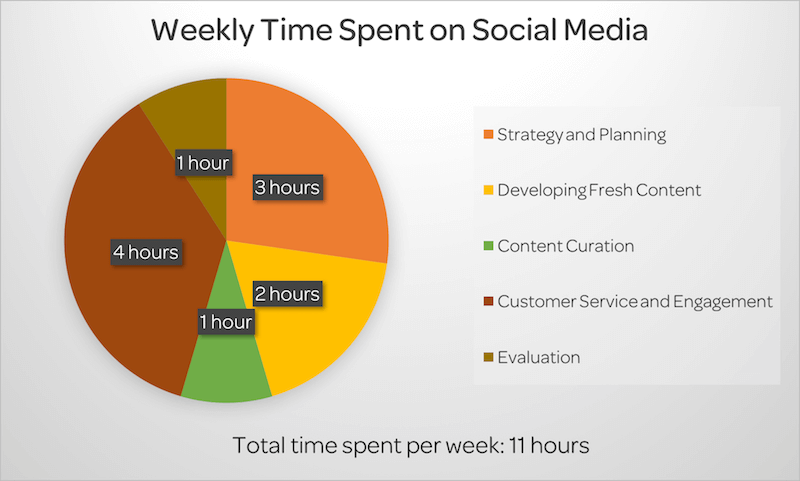How Much Time Should Your Business Spend on Social Media?

Social media marketing has the potential for immense success and smaller businesses can especially benefit from the various, affordable ways to reach out to their target audience and engage in customer service.
At the same time, a simple brand presence on your favorite social media network is not nearly enough. Successful marketing in this environment requires a significant and consistent time investment.
How much time should you spend on social media to market your business?
The answer depends on a number of variables. Still, understanding these variables, and knowing which of them to prioritize, can give you a better idea of how to plan your time for maximum marketing success.
Contents
How Much Time do Marketers Spend on Social Media?
In 2015, Social Media Examiner surveyed almost 4,000 digital marketers to ask the exact question posed above. The results are enlightening:
- 64 percent of marketers spend more than 6 hours per week on social media, and 41 percent actually spend more than 11 hours weekly on the medium.
- Novice social media marketers spend significantly less time on social media than those more experienced with the medium.
- Time spent on social media correlates with business and employee size, which makes sense given the often limited resources for small businesses.
- Age is inversely correlated to time spent on social media. The younger the marketer, the more likely they are to spend more hours on the medium every week.
Of course, understanding how other businesses manage their social media efforts should not be enough to make your own choices.
In addition, it makes sense to build your own social media time management strategy, which depends in large part on the various variables this tasks encompasses.
Understanding the Variables that Influence Your Social Media Time
Successfully marketing your brand on social media means far more than simply posting content. Effective marketers spend their time on Facebook, Twitter, and other networks engaged in a variety of activities:
- Planning and strategy. Who is your target audience? What types of pain points do they have, and how do you plan on reaching them effectively with relevant messaging? How can you measure your success? Successful social media marketing can only be possible with a comprehensive, ongoing strategy.
- Developing and publishing fresh content. Naturally, social media marketing cannot be successful without regular, fresh content. Plan in time to develop that content, as well – visuals, such as infographics and videos, perform particularly well across networks.
- Curating existing content. On most social networks, marketing is most likely to succeed with multiple posts per day. Building fresh content for each post can be difficult, which is why curation has become so wide-spread. Find already popular content, and add your own spin to it.
- Customer service and engagement. Current customers are increasingly shifting to social for brand engagement, but an astounding 89 percent of the messages they send to brands go unanswered. For your retention efforts, keeping current customers in mind is essential.
- Evaluating and adjusting existing efforts. Ultimately, even the most well-intended strategy can fail if no benchmarks allow for evaluation. What works in theory may not actually be successful in practice. That’s why you need to plan significant time for evaluating your current efforts, down to the individual post level.
Which Variables Deserve Further Attention?
Overall, the above five variables will consume most of your social media time. But which actually require the most attention? Simply splitting them up evenly probably doesn’t make much sense; instead, consider a more strategic approach.
Social Media Today, for instance, suggests a heavy emphasis on engaging current customers.
Customer retention is vital to business success, and clients who loudly sing your praises on social media significantly increase your credibility. That warrants a focus on this variable for many expert marketers.
At the same time, don’t underestimate the need for strategy and planning.
Especially if you are just starting out in building a comprehensive digital strategy, this variable could take up a large plurality of your marketing time as you engage in audience research, goal setting, and so on.
When they are just starting out, most marketers spend too much time on fresh content creation.
It’s an undeniably important part of any social media marketing, but should not be the sole focus of your efforts. Instead, balance it with content curation, and make sure your strategic framework is already in place by the time you start.
Finally, it makes sense to plan at least 10% of your time for your evaluation mechanisms. This step has the potential to inform and improve all other variables over time, so it cannot be overlooked.
Keep all of the above information in mind, and your weekly time spent on social media may look something like this:
Exact schedules, of course, may differ based on your available time, business, and audience size.
But given the average time spent by other marketers, and the respective variables involved in the process, it’s a great start to approach social media marketing in a more strategic manner.
Minimizing Functional Tasks to Increase Strategic Focus
Given the amount of time you have to spend on planning and evaluating your social media marketing efforts, reducing the effort you need to expend on more functional tasks is absolutely essential.
An effective strategy, for instance, should include a content calendar that outlines what and when you should publish your posts.
Rather than logging into your social media network(s) of choice each time a post is ready, consider scheduling them ahead with a tool like Postradamus. The same tool can also help you more effectively curate existing content, leaving more time for the strategic elements of social media marketing.
Do you know how much time you should spend on social media?
In most cases, the answer is probably higher than the time you have available. Through understanding your variables, you can approach this crucial marketing channel more strategically, optimizing your efforts over time.



 Please enter your email to continue...
Please enter your email to continue... We don't send spam. You'll only receive email about Postradamus.
We don't send spam. You'll only receive email about Postradamus.
2 comments
This is great information! I had a question though, what if you are a full time marketer, what should you do for the other 29 hours? (I’m a student studying in this field)
Hey Jessica!
As a full-time marketer, you might want to look at these numbers as percentages:
36% of your time would go to engaging with audience
27% to researching and planning your marketing strategy (read a lot!)
18% to developing fresh content
9% to curating content
9% to evaluating your strategy
That’s roughly 100%, but depending on your business model, you will probably set aside some time for other things, such as finding new clients, marketing your own business, or brainstorming ideas with colleagues from other teams.
Hope this helps, and good luck with your studies!